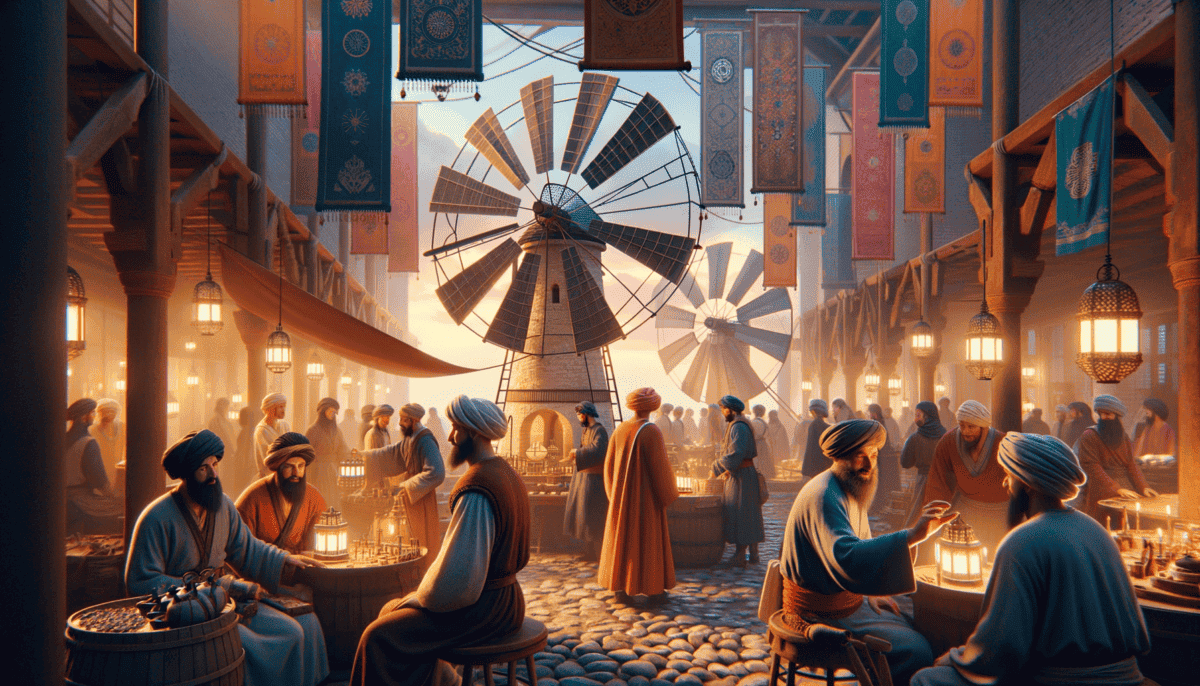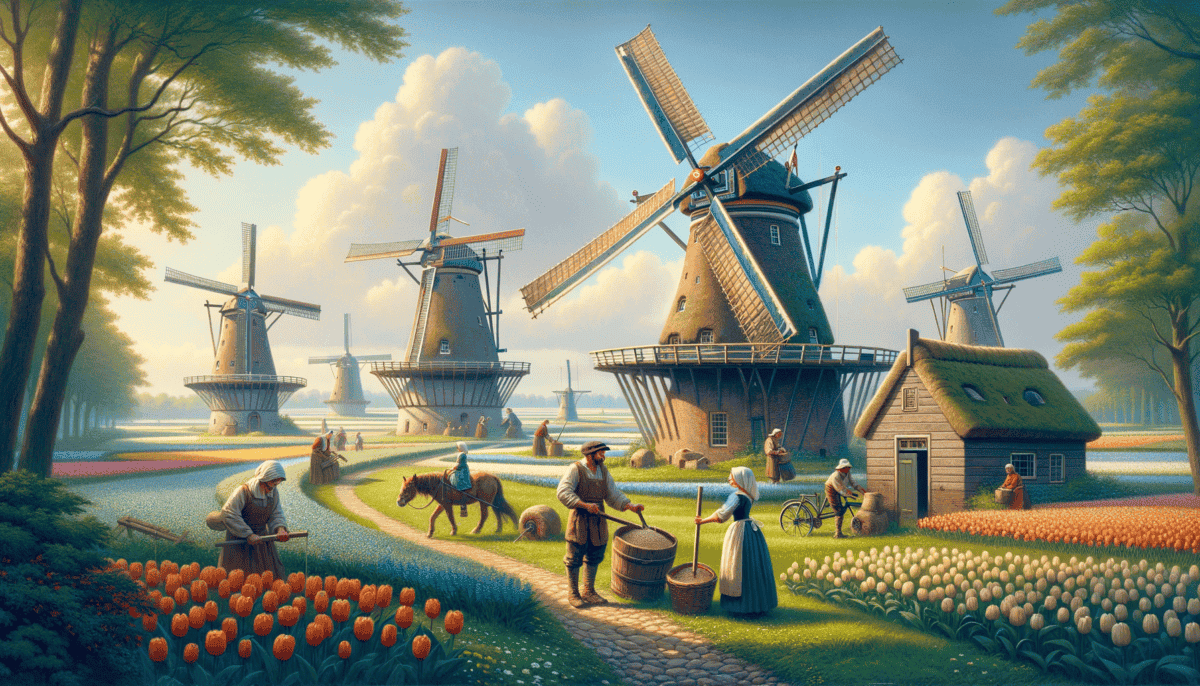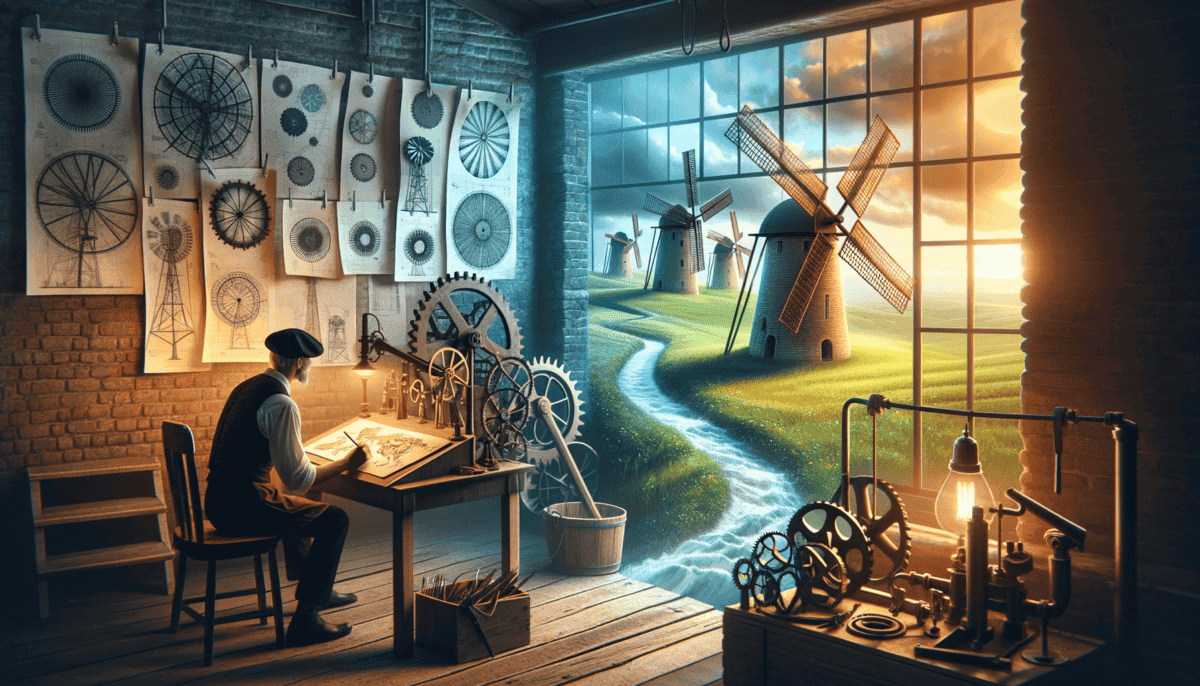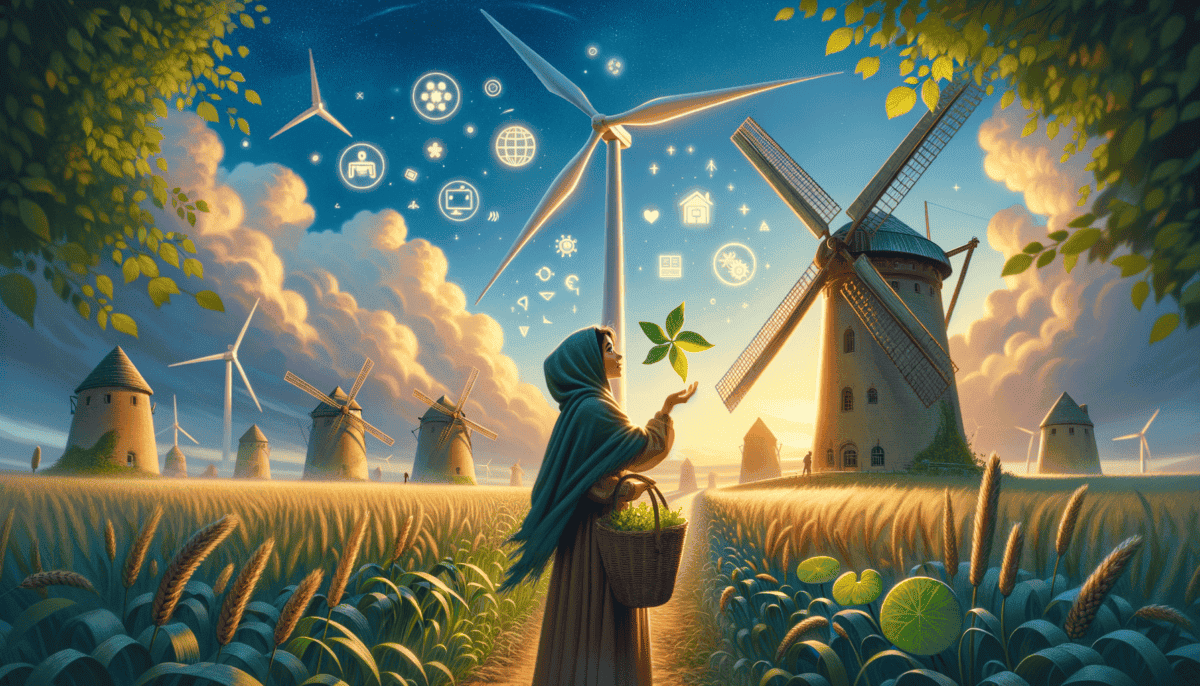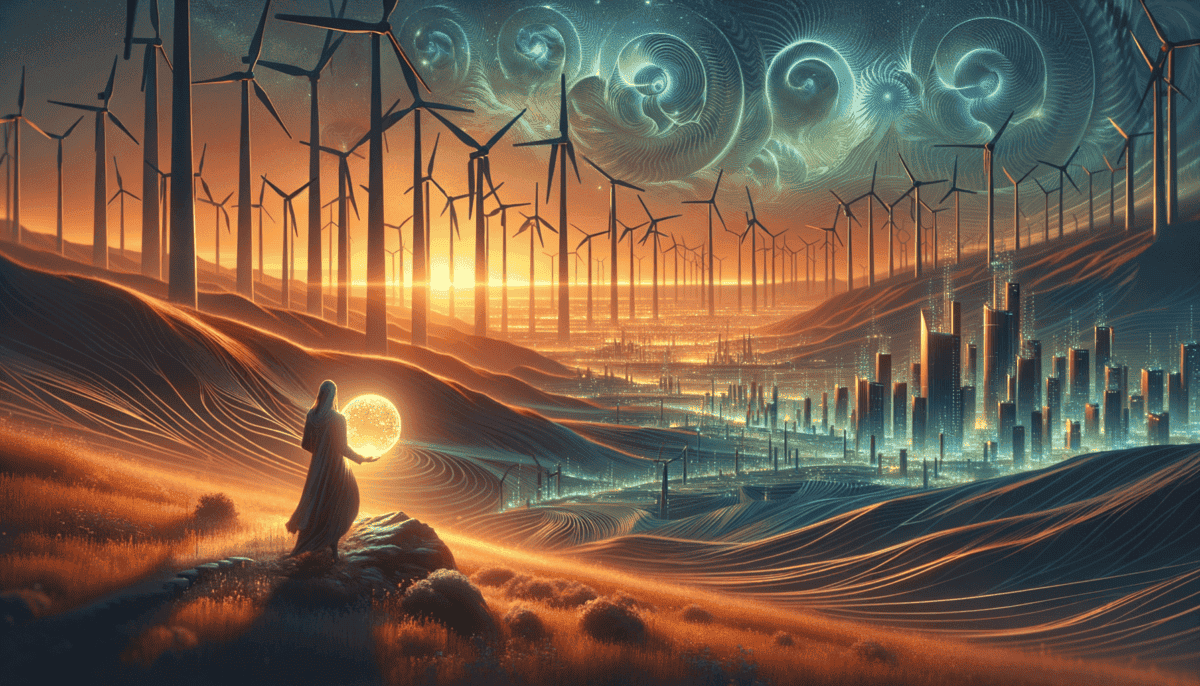Winds of Persia
Long ago in ancient Persia, where the sun was hot and the winds blew strong, lived a clever boy named Darius. He loved watching the desert winds dance across the sand dunes near his village.
"Papa, why can't we make the wind work for us?" Darius asked one day, as he helped his father grind wheat into flour using heavy stones.
His father wiped sweat from his forehead. "That's an interesting thought, my son. The wind is powerful indeed."
Darius couldn't stop thinking about the wind's strength. He noticed how it could lift heavy things and move them around. He watched as it pushed sailing boats across the water and moved tree branches back and forth.
One morning, Darius woke up with an exciting idea. He gathered some wood, cloth, and rope from around his home. His little sister Aria watched curiously as he worked.
"What are you making, brother?" she asked, peeking over his shoulder.
"I'm going to catch the wind!" Darius replied with a big smile.
He built a tall wooden frame and attached pieces of cloth to it, like sails on a boat. When the wind blew, the cloth pieces spun around! He connected this to a grinding stone, and something amazing happened – the stone began to turn by itself!
The very first windmill was born.
News of Darius's invention spread quickly through the village. Soon, other families wanted windmills too. They used them to grind grain and pump water from deep underground.
"You've done something wonderful," his father said proudly. "Now our work is easier, and we can help more people."
The other children in the village called Darius "The Wind Catcher." He taught them how to make small toy windmills that spun in the breeze.
“The wind is no longer just our friend,” Darius would say. “It’s now our helper too!”
As the seasons passed, people made the windmills better and stronger. They built them bigger and used different materials. Traders who visited the village saw the windmills and were amazed. They took the idea with them to other lands.
Little did Darius know that his clever invention would spread across the world and change how people lived. His simple idea of "catching the wind" would grow into something much bigger than he ever imagined.
The warm Persian winds continued to blow across the land, but now they didn't just move the sand – they helped people work and live better lives. And it all started with a curious boy who looked at the wind and saw possibility.
Sailing the Winds of Change
As traders traveled between Persia and distant lands, they carried stories of the amazing wind-catching machines. One such trader was Ahmad, who loved sharing tales of the wonderful windmills.
“Look at this drawing,” Ahmad would say, showing people in new cities how the windmills worked. “The wind makes it spin, and it can help you work!”
In China, a wise craftsman named Li Wei heard about the Persian windmills. He thought of a new way to make them better.
“What if we make the sails from bamboo?” he wondered. “It’s light and strong!”
Li Wei’s bamboo windmills were perfect for pumping water into the rice fields. The farmers were very happy!
“Now the wind helps our rice grow better than ever before!” the farmers would say with big smiles.
Meanwhile, in India, a clever girl named Priya watched the trading ships in the harbor. She saw their big sails catching the wind.
“Papa,” she said to her father, who was a cloth maker, “what if we use our strong cotton cloth to make windmill sails?”
Her father’s eyes lit up. “That’s brilliant, Priya! Our cloth is perfect for catching the wind!”
Soon, Indian windmills had beautiful cotton sails that spun in the breeze.
The windmills changed as they traveled to new places. Some were tall, others were small. Some had many sails, others had few. But they all did the same important thing – they helped people work better! Here are some ways people used windmills:
- Grinding grain into flour
- Pumping water for farms
- Making paper from wood
- Crushing sugar cane
One day, a group of children from different lands met at a big trading port. Though they spoke different languages, they all knew about windmills.
“In my country, they look like this!” said one child, drawing in the sand.
“Ours are different!” said another, adding to the drawing.
They spent the whole afternoon sharing stories about their windmills. Even though they came from far away places, the windmills brought them together.
The traders continued their journeys, and with them, the story of windmills sailed across seas and over mountains. Each new place added its own ideas, making the windmills even better.
Ahmad smiled as he prepared for another journey. He knew that somewhere, in another far-off land, someone would see a windmill for the first time and think, “What a wonderful way to catch the wind!”
And so, the wind kept blowing, the windmills kept turning, and the story of these amazing machines continued to grow.
The Dutch Windmill Tale
In a land where water and sky meet, little Hendrik lived with his family in Holland. His father was a miller who worked in a tall windmill that stood proud against the blue sky.
“Papa, why are our windmills so big?” Hendrik asked one morning, helping his father check the giant sails.
“Because, my son,” his father smiled, “we Dutch have a special job for our windmills. They help us keep our feet dry!”
Hendrik looked confused. “Keep our feet dry?”
“Yes! You see, much of our land is below sea level. Without windmills pumping water away, our homes would be underwater!”
“The windmills are like giant helpers, scooping up water and moving it away from our towns,” Papa explained, making a scooping motion with his hands.
Every day, Hendrik watched the mighty windmills at work. Their huge sails turned in the wind, powering big wooden scoops called “scoopwheels.”
The scoopwheels lifted water from the low ground and poured it into rivers that flowed to the sea.
But the Dutch windmills didn’t just pump water. They did many jobs:
- Made flour from grain
- Cut wood into planks
- Crushed rocks to make paint
- Ground spices into powder ✨
One stormy day, Hendrik’s sister Maria ran into the windmill, her eyes wide with worry.
“Papa! The water is rising in the village!” she cried.
Papa quickly checked the wind direction. “We need to turn the cap!” he said. “Hendrik, help me!”
Together, they used a special wheel to turn the top of the windmill so its sails faced the strong wind. The mighty sails began to spin faster.
“Look!” Maria pointed through the window. The water level was going down as their windmill worked harder.
“Our windmill saved the day!” Hendrik cheered.
Word spread about how well Dutch windmills worked. People came from far away to learn about them. Soon, similar windmills appeared in other parts of Europe.
As Hendrik grew older, he became a miller like his father. He loved teaching others about windmills.
“These aren’t just machines,” he would say. “They’re part of who we are. They show how people can work with nature to do amazing things!”
The Dutch windmills became famous all over the world. They stood like friendly giants watching over the land, their sails turning peacefully in the wind. Many still stand today, reminding us of how clever people can be.
At sunset, Hendrik would often sit with his own children, watching the windmill’s sails turn against the orange sky. The wind whispered stories of how these magnificent machines had changed their world, one turn at a time.
The Age of Innovation
The sun rose over a bustling English town, where smoke curled from tall factory chimneys. A young inventor named Thomas stood at his workbench, studying drawings of windmills.
“These old windmills are amazing,” Thomas said to his cat, Gears. “But I think we can make them even better!”
Thomas wasn’t alone. All across Europe and America, clever people were thinking of new ways to use wind power. They wanted to make machines work faster and better.
“Look here, Gears,” Thomas pointed to his drawing. “What if we made the blades out of metal instead of wood?”
Metal was stronger than wood. It wouldn’t rot in the rain or crack in the sun. This was just one of many new ideas people had.
“The wind is free,” Thomas often said. “We just need to learn how to use it better!”
One morning, Thomas got exciting news. His friend Sarah, who lived on a farm, needed help. Their old wooden windmill wasn’t working well enough to pump water for their crops.
This was Thomas’s chance to try his new ideas!
He designed a new kind of windmill with these special features:
- Metal blades that spun more easily ️
- Better gears that turned more smoothly ⚙️
- A tail that helped it face the wind
- A brake to stop it during storms ⛈️
“This is different from any windmill I’ve ever seen!” Sarah said when the new windmill was ready.
“Just watch,” Thomas smiled, as the wind picked up.
News of Thomas’s windmill spread quickly. Farmers came from miles around to see it. Many wanted one just like it for their own farms.
“Can you build us one too?” they asked.
Soon, Thomas was very busy. He built windmills for farms, factories, and even trains that needed water. Each time, he tried to make them a little better.
But the biggest change was still to come. Some inventors had an idea: What if windmills could make electricity? ⚡
“Imagine lights powered by the wind!” Thomas told Gears excitedly. “No more candles or oil lamps needed!”
People started building windmills with special parts called generators. These could turn wind power into electricity.
One day, Sarah visited Thomas’s workshop. The room was full of drawings and metal parts.
“Your new windmills are so different from the old ones,” she said.
“Yes,” Thomas nodded. “But they still do what windmills have always done – they help people use the power of the wind to make their lives better.”
As the sun set, Thomas and Sarah watched his newest windmill spinning against the purple sky. Its metal blades gleamed in the last light of day.
“I wonder what windmills will look like in the future,” Sarah said.
Thomas smiled. “I bet they’ll be amazing. As long as the wind blows, people will keep finding new ways to use it!”
Winds of Change
Maya stood at her desk, surrounded by colorful drawings of modern wind turbines. She was an engineer who loved finding new ways to use wind power. ️
“These aren’t your grandmother’s windmills anymore!” Maya told her little brother Tim, who was visiting her office.
“How did they get so big?” Tim asked, his eyes wide with wonder.
Maya picked up a model of a modern wind turbine. “Well, we learned that bigger blades catch more wind. And catching more wind means making more power!”
She pointed out the window to a wind farm in the distance. Dozens of giant white turbines spun slowly against the blue sky.
“Each one of those turbines is like a gentle giant, helping us make clean energy from the wind.”
Tim pressed his nose against the window. “They look like huge pinwheels!”
Maya laughed. “They do! But these pinwheels help fight climate change.”
She showed Tim some interesting facts about modern wind power:
- Wind turbines can be taller than the Statue of Liberty
- Their blades can be longer than a football field
- Some can power over 1,000 homes with just one turn ⚡
- They work day and night, rain or shine
“Want to see something really cool?” Maya asked. She pulled out her tablet, showing Tim a special program.
“Can we visit them up close?” Tim asked excitedly.
“Of course! Let’s go on a field trip.”
At the wind farm, Tim felt tiny next to the massive turbines. Their white blades swooped through the air with a gentle whoosh.
“Listen,” Maya said. “That’s the sound of clean energy being made.”
A technician named Joe came to show them around. He wore a bright orange safety vest and a hard hat.
“These turbines are smart,” Joe explained. “They have computers inside that help them work better.”
“Like robots?” Tim asked.
“Kind of! They can turn themselves to catch the best wind, and even shut down if a storm comes.”
Maya showed Tim how they were building new turbines in the ocean. “We call them offshore wind farms,” she said.
“Why put them in the water?” Tim wondered.
“The wind over the ocean is stronger and steadier. Plus, there’s lots of space out there!”
As they drove home, Tim couldn’t stop talking about what he’d learned. “I want to work with wind turbines when I grow up!”
Maya smiled. “Maybe you’ll help design the next generation of wind power. They might be even bigger and better than what we have now!”
Looking in the rearview mirror, she saw the turbines growing smaller in the distance. Their blades kept spinning, making clean energy for thousands of homes. ⚡
“The best part is,” Maya said, “as long as the wind blows, we’ll have power. And the wind will always blow!”
That night, Tim drew pictures of future wind turbines in his notebook. He imagined them floating in the sky or hidden underwater. Who knew what amazing ideas people would think of next?
Winds of Tomorrow
The sun was setting behind a field of gleaming wind turbines as Dr. Maya Rodriguez stepped onto the stage. Ten years had passed since that special day with her little brother Tim. Now, she was about to reveal something amazing.
“Ladies and gentlemen,” Maya began, “welcome to the future of wind power!”
In the front row sat Tim, now a young engineer himself. He couldn’t help but smile as Maya pulled back a curtain to reveal a hologram of their new invention.
“This is the WindBridge,” Maya announced. “A network of floating wind turbines that work together like a team!”
“When I was little, my sister showed me that wind power could change the world. Now we’re making that dream even bigger!”
– Tim Rodriguez
The audience gasped as the hologram showed beautiful floating turbines dancing in the sky. They looked like giant silver dandelions catching the wind.
The WindBridge could power entire cities using just the wind and sun, working together in perfect harmony.
Tim stood up to join his sister on stage. Together, they showed how their new turbines could:
- Float high in the sky where winds are stronger
- Share power with each other like friends sharing toys
- Dance around storms like leaves in the wind
- Fix themselves using tiny helper robots
“Remember Joe?” Maya asked the audience. “Our friend from the wind farm?”
Joe stood up, still wearing his orange vest after all these years. “These new turbines are like nothing I’ve ever seen!”
Tim pressed a button, and a real WindBridge prototype rose into the air outside. Its silver blades sparkled in the sunlight.
“Look how far we’ve come,” Maya said proudly. “From ancient Persian windmills to floating power stations in the sky!”
After the presentation, a young girl tugged on Tim’s sleeve. “Can I be a wind engineer too?”
Tim knelt down beside her. “Of course you can! The wind belongs to everyone. We just have to learn how to dance with it.”
“In fact,” Maya added, “we need more dreamers like you. The story of wind power isn’t over – it’s just beginning!”
That evening, Maya and Tim stood together watching their WindBridge float peacefully above the city. Its gentle humming reminded them of those first windmills that started it all.
“You know what’s amazing?” Tim said. “Every time we think we’ve learned everything about wind power, we discover something new!”
Maya nodded. “That’s because the wind never stops surprising us. It’s been teaching us new things for thousands of years.”
As stars began twinkling in the sky, the siblings watched their creation power thousands of homes with clean, endless energy. The wind that once turned simple wooden mills in ancient Persia now danced with floating silver turbines in the clouds.
And somewhere, perhaps, a young inventor was already dreaming up the next chapter in this incredible story – because as long as the wind blows, human imagination will soar with it.
The little girl from the presentation was right – this was just the beginning of an even greater adventure. The winds of change were blowing stronger than ever, carrying us all toward a cleaner, brighter tomorrow. ✨


